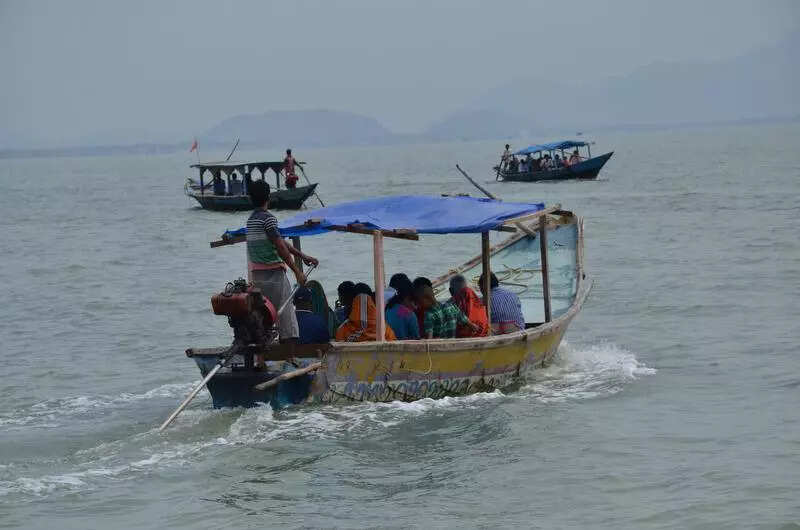HC registers PIL to monitor conservation of 6 Ramsar wetlands in state | Bhubaneswar News

Cuttack: Orissa high court has initiated a suo motu PIL to monitor the conservation of six wetlands in the state, recognised under the Ramsar Convention. The wetlands — Chilika lake, Bhitarkanika mangroves, Satkosia gorge, Tampara lake, Hirakud reservoir and Ansupa lake — cover a total area of 345,628 hectares.
The proceeding was initiated recently following a Supreme Court order on Dec 11 last year, which called for the protection of 85 Ramsar sites across the country. The SC directed each of the state/UT wetland authorities “to complete ground truthing as well as the demarcation of wetland boundaries of each of the wetlands identified for their state by Space Application Centre (SAC) Atlas, 2021, within three months”.
High courts were also directed “to ensure that the Ramsar sites within their jurisdiction are properly maintained”. Accordingly, on Jan 22, a bench of acting Chief Justice Arindam Sinha and Justice M S Sahoo scheduled the next hearing for Feb 12 to assess the progress of the implementation of the SC order with authorities concerned told to file affidavits by then.
The bench also tagged for hearing the PIL initiated earlier following an SC order on April 3, 2017, in continuation of which the Dec 11, 2024, order was issued by the apex court. The Dec 2024 order was in continuation of the order issued on April 3, 2017, to 15 high courts (one of them being Orissa HC) to initiate a suo motu PIL to conserve 26 major wetlands under their jurisdiction, which were Ramsar sites.
Accordingly, the HC then suo motu registered a PIL for the conservation of Chilika lake and Bhitarkanika mangroves, which were by then designated as Ramsar sites, and appointed advocate Mohit Agarwal as amicus curiae on Sept 19, 2017. Subsequently, Agarwal raised six issues to be considered by the court for the preservation of the two wetlands — illegal prawn culture, pollution, uncontrolled boat operation and oil spills, siltation, depletion of mangrove forests of Bhitarkanika and prawn culture by illegal Bangladeshi migrants, and poaching.
HC has been monitoring the identification of areas where illegal prawn culture is ongoing and the demolition of such gherries, eviction of illegal occupants and simultaneous lodging of criminal cases against the offenders. SC’s Dec 2024 order expanded the protection area to four more wetlands in the state — Satkosia gorge, Tampara lake, Hirakud reservoir and Ansupa lake (spread over a total area of 164,128 hectares), which were designated as Ramsar sites on Oct 12, 2021.
Cuttack: Orissa high court has initiated a suo motu PIL to monitor the conservation of six wetlands in the state, recognised under the Ramsar Convention. The wetlands — Chilika lake, Bhitarkanika mangroves, Satkosia gorge, Tampara lake, Hirakud reservoir and Ansupa lake — cover a total area of 345,628 hectares.
The proceeding was initiated recently following a Supreme Court order on Dec 11 last year, which called for the protection of 85 Ramsar sites across the country. The SC directed each of the state/UT wetland authorities “to complete ground truthing as well as the demarcation of wetland boundaries of each of the wetlands identified for their state by Space Application Centre (SAC) Atlas, 2021, within three months”.
High courts were also directed “to ensure that the Ramsar sites within their jurisdiction are properly maintained”. Accordingly, on Jan 22, a bench of acting Chief Justice Arindam Sinha and Justice M S Sahoo scheduled the next hearing for Feb 12 to assess the progress of the implementation of the SC order with authorities concerned told to file affidavits by then.
The bench also tagged for hearing the PIL initiated earlier following an SC order on April 3, 2017, in continuation of which the Dec 11, 2024, order was issued by the apex court. The Dec 2024 order was in continuation of the order issued on April 3, 2017, to 15 high courts (one of them being Orissa HC) to initiate a suo motu PIL to conserve 26 major wetlands under their jurisdiction, which were Ramsar sites.
Accordingly, the HC then suo motu registered a PIL for the conservation of Chilika lake and Bhitarkanika mangroves, which were by then designated as Ramsar sites, and appointed advocate Mohit Agarwal as amicus curiae on Sept 19, 2017. Subsequently, Agarwal raised six issues to be considered by the court for the preservation of the two wetlands — illegal prawn culture, pollution, uncontrolled boat operation and oil spills, siltation, depletion of mangrove forests of Bhitarkanika and prawn culture by illegal Bangladeshi migrants, and poaching.
HC has been monitoring the identification of areas where illegal prawn culture is ongoing and the demolition of such gherries, eviction of illegal occupants and simultaneous lodging of criminal cases against the offenders. SC’s Dec 2024 order expanded the protection area to four more wetlands in the state — Satkosia gorge, Tampara lake, Hirakud reservoir and Ansupa lake (spread over a total area of 164,128 hectares), which were designated as Ramsar sites on Oct 12, 2021.
The proceeding was initiated recently following a Supreme Court order on Dec 11 last year, which called for the protection of 85 Ramsar sites across the country. The SC directed each of the state/UT wetland authorities “to complete ground truthing as well as the demarcation of wetland boundaries of each of the wetlands identified for their state by Space Application Centre (SAC) Atlas, 2021, within three months”.
High courts were also directed “to ensure that the Ramsar sites within their jurisdiction are properly maintained”. Accordingly, on Jan 22, a bench of acting Chief Justice Arindam Sinha and Justice M S Sahoo scheduled the next hearing for Feb 12 to assess the progress of the implementation of the SC order with authorities concerned told to file affidavits by then.
The bench also tagged for hearing the PIL initiated earlier following an SC order on April 3, 2017, in continuation of which the Dec 11, 2024, order was issued by the apex court. The Dec 2024 order was in continuation of the order issued on April 3, 2017, to 15 high courts (one of them being Orissa HC) to initiate a suo motu PIL to conserve 26 major wetlands under their jurisdiction, which were Ramsar sites.
Accordingly, the HC then suo motu registered a PIL for the conservation of Chilika lake and Bhitarkanika mangroves, which were by then designated as Ramsar sites, and appointed advocate Mohit Agarwal as amicus curiae on Sept 19, 2017. Subsequently, Agarwal raised six issues to be considered by the court for the preservation of the two wetlands — illegal prawn culture, pollution, uncontrolled boat operation and oil spills, siltation, depletion of mangrove forests of Bhitarkanika and prawn culture by illegal Bangladeshi migrants, and poaching.
HC has been monitoring the identification of areas where illegal prawn culture is ongoing and the demolition of such gherries, eviction of illegal occupants and simultaneous lodging of criminal cases against the offenders. SC’s Dec 2024 order expanded the protection area to four more wetlands in the state — Satkosia gorge, Tampara lake, Hirakud reservoir and Ansupa lake (spread over a total area of 164,128 hectares), which were designated as Ramsar sites on Oct 12, 2021.
Cuttack: Orissa high court has initiated a suo motu PIL to monitor the conservation of six wetlands in the state, recognised under the Ramsar Convention. The wetlands — Chilika lake, Bhitarkanika mangroves, Satkosia gorge, Tampara lake, Hirakud reservoir and Ansupa lake — cover a total area of 345,628 hectares.
The proceeding was initiated recently following a Supreme Court order on Dec 11 last year, which called for the protection of 85 Ramsar sites across the country. The SC directed each of the state/UT wetland authorities “to complete ground truthing as well as the demarcation of wetland boundaries of each of the wetlands identified for their state by Space Application Centre (SAC) Atlas, 2021, within three months”.
High courts were also directed “to ensure that the Ramsar sites within their jurisdiction are properly maintained”. Accordingly, on Jan 22, a bench of acting Chief Justice Arindam Sinha and Justice M S Sahoo scheduled the next hearing for Feb 12 to assess the progress of the implementation of the SC order with authorities concerned told to file affidavits by then.
The bench also tagged for hearing the PIL initiated earlier following an SC order on April 3, 2017, in continuation of which the Dec 11, 2024, order was issued by the apex court. The Dec 2024 order was in continuation of the order issued on April 3, 2017, to 15 high courts (one of them being Orissa HC) to initiate a suo motu PIL to conserve 26 major wetlands under their jurisdiction, which were Ramsar sites.
Accordingly, the HC then suo motu registered a PIL for the conservation of Chilika lake and Bhitarkanika mangroves, which were by then designated as Ramsar sites, and appointed advocate Mohit Agarwal as amicus curiae on Sept 19, 2017. Subsequently, Agarwal raised six issues to be considered by the court for the preservation of the two wetlands — illegal prawn culture, pollution, uncontrolled boat operation and oil spills, siltation, depletion of mangrove forests of Bhitarkanika and prawn culture by illegal Bangladeshi migrants, and poaching.
HC has been monitoring the identification of areas where illegal prawn culture is ongoing and the demolition of such gherries, eviction of illegal occupants and simultaneous lodging of criminal cases against the offenders. SC’s Dec 2024 order expanded the protection area to four more wetlands in the state — Satkosia gorge, Tampara lake, Hirakud reservoir and Ansupa lake (spread over a total area of 164,128 hectares), which were designated as Ramsar sites on Oct 12, 2021.
















